In what has become something of a yearly ritual, Gary Williams summoned paddlers and rowers of all stripes to Shady Beach with promises of wealth and glory. Such is the Shangri-la allure of the Lighthouse to Lighthouse Race that we keep returning, even though what actually awaits most of us is blisters and humiliation. That’s life in a nutshell, right? We’re not exactly off to a rollicking start here, but I guarantee that things will get better… before inevitably ending in suffering. In that spirit, read on!
A side note. In response to a number of readers questioning the veracity of my reports, I decided to employ a professional fact checker. Rather than making changes in response to hypothetical errors, I figured the doubters would find it illuminating to see just how scrupulously to the truth I hew. Therefore, in the rare instances of petty deviations from reality, I’ll just include the fact checker’s (FC) comments as provided. [FC: No actual fact checker reviewed this document.] Good one, fact checker! This site doesn’t support emojis in reports, but I’m sure a winky was intended there. [FC: Red X emoji, accompanied by game show buzzer sound.]
I’ve suggested to Gary numerous times that he drop the “East Coast Surfski Championship” subtitle to the L2L in favor of something with a little less talent-drawing pizzazz – perhaps “Just Another Race” or, better yet, “Featuring Toxic Algal Blooms!” [FC: Unlikely, since Gary has long since blocked the author from all social media platforms, changed his phone number, and now shuttles between a series of safe houses.] Nevertheless, the unfortunate moniker persists. As a result, the L2L consistently assembles the most talented pool of paddlers east of the Gorge. For those provincials used to racing primarily against the local New England crowd (with an acceptable level of bleed-over from the greater metro NYC area), the increase in competition is downright disheartening.
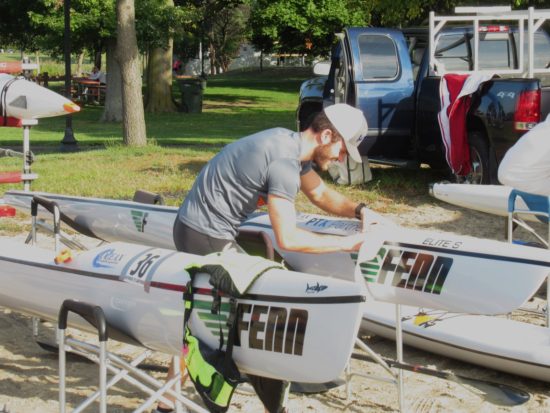
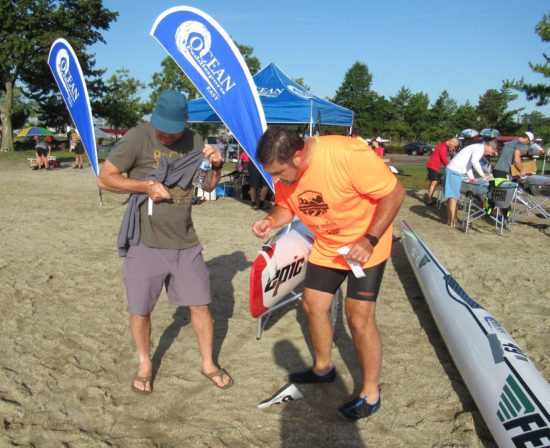
After a three year absence, Austin Kieffer was once again penciled in to annihilate the field. [FC: A pen was used.] There was some debate over how to fill the remaining podium spots, however, so in truly barbaric fashion, the paddlers were thrown onto the water to let natural selection takes its course. I had my money on Floridian Flavio Costa for silver, mostly because of all the cool tattoos. I wasn’t ruling out Canadian Vadim Lawrence or Unfortunate Rob Jehn (hey, that’s what I got when I googled “What do you call someone from New Jersey?”) though, so was forced to spread my trifecta bets around. [FC: While not strictly false, cheap shots at the Garden State would be beneath most authors.] I tried to drum up some wagers on me reaching the podium (in the hopes of then cutting a deal with the bookies to take a dive – perhaps literally), but my faked man-in-the-crowd cries of “What about Lesher? He’s looking strong!” were met with little more than a smattering of good-natured chuckles. [FC: Technically, gales of derisive laughter.] Well, I thought, the best response to this borderline indifference [FC: Ridicule.] will be to get out there and finish a strong 7th.
I’m sure most of you know the course by now, but to prevent readers from missing a turn and being summarily disqualified, I’ll recap. We’ll start off of Shady Beach, round Sprite Island, cruise past Peck Ledge Lighthouse, go around Goose Island, and head towards Copps Island. By this point in the narrative, you’ll probably just want to skip ahead a couple dozen paragraphs to find out who won the doubles race, but I’ll have already told you (Max Yasochka and Andrius Zinkevichus), so you’ll need to push on past Sheffield Island, round Greens Ledge Light, then plow back through everything in reverse. You may find it easier to read in a mirror held perpendicular to your screen. The good news is that the 14 mile race generally comes in at around 13.3 miles, so you’ll finish 5% sooner than you expected. With mild wind making for a particularly fast race, you’ll be out of here in no time. [FC: And yet you’ll be surprised by how often you check the clock during that non-existent span.]
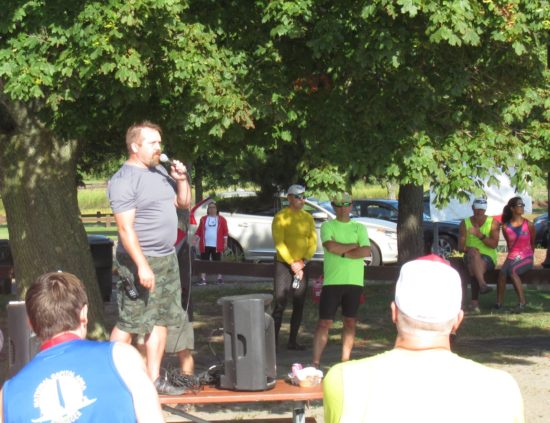
After a brief but surprisingly expletive-laden captain’s meeting (couldn’t get my darned PFD zipper unstuck), the HPK class hit the water, circling anxiously while the other waves were given their shot. Eventually, the surfskis took the stage. When you find yourself being consistently out-sprinted by three-quarters of the field at the start (including that one guy you just cannot believe is ahead you) [FC: “man, woman, or child” would be more accurate than “guy”.], you continue to do the exact same thing for 5 years, then do start-specific training for 3 years to no discernible benefit, and finally accept that you’re a worthless slug undeserving of love or respect. Having now embraced my gastropod status, at least I’m able to adopt the compensatory strategy of positioning myself at the extreme end of the starting line. The first couple of minutes are just as demoralizing, but at least you’re free from the contemptuous paddle spray of your superiors. And less likely to be involved in the kind of right-of-way squabbles that have soured my relationships with any number of elderly paddlers.
A quick roll call satisfied, we were counted down to the start. Given that Austin is hands-down the best American ski paddler (and I wouldn’t hesitate to say the same thing of Pat Dolan, had he been at the L2L instead), his immediate and commanding lead was unsurprising. Flavio made a plucky effort to hold on Austin’s stern off the line, but moxie will only get you so far. Say 150 meters, tops. A long line of indistinguishable competitors strung out behind Flavio. The course angles obliquely around an orange buoy after an initial straight-away of perhaps a quarter-mile. Although my pre-race objective had been to reach that turn in the top five whatever the cost, I’m nothing if not irresolute. If circumstances demanded that I recalibrate my short-term ambition, so be it. Let’s go with top ten by the turn, shall we? Inching by Kurt Hatem while passing the buoy, I swelled with pride at achieving my updated goal. [FC: This may be more editorial suggestion than fact, but the author might consider using the phrase “pathetic capitulation” when referring to this revision.]
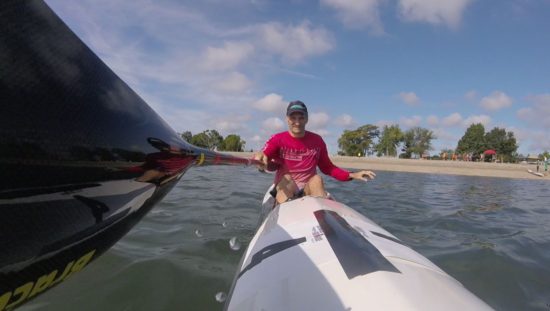
It took me another couple minutes to get clear of Ronald Zavala, after which a mere 7 paddlers separated me from a glorious (but distant) second place to Austin. You may be confused because above I highlighted three competitors to beat (Flavio, Vadim, and Rob), yet there were more than double that yet ahead of me. I was similarly flummoxed. My ego had once again punk’d me, using a time-tested combination of arrogance and ignorance to inflate my expectations. I recognized a couple of the paddlers ahead from previous races (Paul Facteau and Ed Joy), but two other were unknown to me (as it turned out, Chris Norman and Phill Lloyd). At Peck Ledge Lighthouse, Austin was well ahead of everyone, with Flavio and Vadim in fruitless pursuit. The remaining paddlers were lined single-file behind their stalwart locomotive, Rob.
Frustrated at the immutable three length gap that separated me from the back of the Jehn train [FC: And, apparently, ignorant of the definition of “immutable”.], I took a wide turn around the shallows of Goose Island to position myself outside of the pack. Perhaps I’d get a boost from paddling in undisturbed water. Or maybe a little extra help from the incoming tide surging into the Sound. Or, as a remote possibility, I’d pretty much remain exactly the same distance behind Rob. Against all odds, it turns out… that last one. Although my tactic was futile, I did manage to move up the hierarchy as first Chris, then Ed, lost the draft and dropped off. For the next couple of miles, I paced Rob, Phill, and Paul from 50 meters outside and several lengths back.
Somewhere adjacent to Sheffield Island, Paul fell three or four lengths behind Rob and Phill. I had tangled with Paul once before. In the 2017 race, he graciously cramped up in the final half-mile to grant me my only top five L2L finish. Paul is an inland paddler with impeccable flatwater credentials, but very limited ocean experience. Interesting fact – because his land-locked status prevents him from eating enough krill, Paul takes dietary supplements to maintain his healthy pinkish-orange skin tone. [FC: Er… I’m not sure where to even start with this one.] Given that I wasn’t making up any ground on him via conventional means, I put in a VHF call to my fisherman friend Scotty D to see if he could unlevel the playing field with some targeted wakes from his 38′ trawler. [FC: Scott “Scotty” DiFranco strenuously denies involvement, but wants to know when to expect those tenderloins the author promised.] Sure enough, I soon saw Paul bobbing beside his boat. After ascertaining that he was OK and reminding him to “krill up” while he had the chance, I moved off in pursuit of the leaders. Although I’d get glimpses of Paul behind me over the next few miles, the sea had grown wobbly enough that I didn’t feel the need to radio in additional surgical strikes from Scotty.
Rounding Greens Ledge Light, Rob and Phill were perhaps 15 lengths ahead. Vadim had fallen off the pace a bit and was in danger of being caught by these two. Rob and Vadim had finished within seconds of one another a couple of months earlier at the Blackburn, scarcely a minute behind me. [FC: True, but a shameless and gratuitous aside. Let’s hope the author gets his comeuppance.] Now heading back towards the start, I traded pleasantries with those approaching paddlers still on the way to the lighthouse. My buddies would say “Good job!” or “Keep it going!”, and I’d reply “Urggh.” or “Would it have killed you to have ‘accidentally’ collided with one of the lead boats?” So-called buddies.
All of our speeds had dropped as a modest tide was now pushing us back. I wasn’t losing ground to Rob and Phill, but neither was I gai… Whoosh! What the hell is happening? The sudden appearance of an unknown bearded competitor steaming past at an improbable speed threw me into muddled confusion. I hadn’t reduced my effort appreciably, so how could someone paddling this powerfully have possibly been behind me for 9 miles? The answer, as it turns out, is that Chris hadn’t been feeling that well during the first half of the race, but had – unfortunately – since recovered. With a biblical vengeance.
I can’t be sure if it was meant as a courtesy or a taunting challenge, but Chris had passed close enough to me that hopping on his draft was a simple matter of pivoting a few degrees to the right and increasing my power output by about 75%. I quickly took a tally. Renewed focus on technique was good for maybe 3%, my cardiovascular system was willing to pitch in 6%, and sheer grit promised no actual power gain, but after some haggling conceded to do everything in its power to maintain bowel control. So, 9% and some degree of continence confidence. Not quite enough for a steady-state draft off of Chris, but I got in a solid 30 seconds before my grit finally gave out, explosively. [FC: This gig does not pay well enough.]
After prying himself free from my anemic grip, Chris’ relentless pace slackened enough that he was able to linger just out of reach. I waffled for the next ten minutes about whether to mount a Pyrrhic interval in an effort to catch him, after which the decision was mercifully taken out of my hands. By the time we reached the end of Sheffield Island, Chris had left in pursuit of greener paddlers. Having lost my chance to hitch a ride up to Rob and Phill, I resigned myself to just worrying about being caught from behind. I was sure that Matt Drayer – my nemesis from our weekly Salem League races – had been hunting me down for miles. And if Paul’s genetic instincts ever kicked in, there’s no telling what heights he might reach while working against the current. The terror of being overtaken provided enough impetus to keep me within a minute of the pack ahead – close enough that I could maintain the fantasy that with just another lap or two, I would have caught them.
As foretold in all the reputable augury guides, Austin secured the gold medal with a time of 1:41:09. [FC: Entrails Weekly actually had him in third, but a junior shaman is currently under investigation for goat tampering.] Flavio was a convincing second. Vadim’s mid-race lull didn’t cost him, as a strong finishing drive propelled him to the final podium spot. Although Chris caught Phill in the final stretch, Rob held on to claim fourth. Rounding out the top ten were me, Matt, Paul, and Ed. On the women’s side, the top three were Rory Bohm, newcomer Alessia Faverio, and Mary Beth. In the SS20+ class, the winners were John Redos (edging out John Costello in a reverse of their Blackburn finish) and Pam Boteler. You already know about Max and Andrius in the double, but how about the age-category-defying duo of septuagenarian Roger Gocking and teen Scott Visser finishing less than a minute behind?
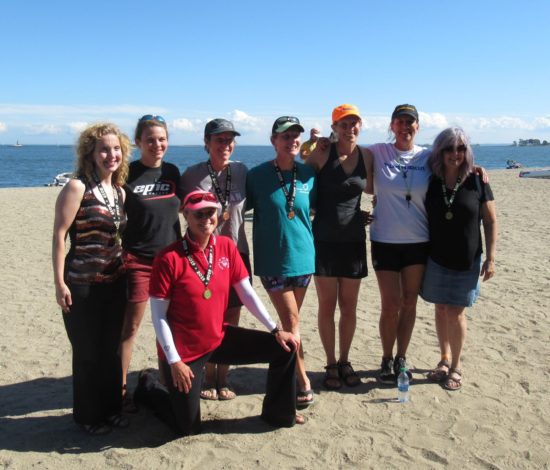
A half-dozen kind (but obviously delusional) people asked me after the race if I had taken second. What?!? Where were you when I was trying to drum up bets before the race? In any event, after seeing the crest-fallen expressions on the first couple of questioners’ faces when confronted with the awful truth, I started telling folks that I would have placed much higher had I not contracted a bad case of lupus midway through the race. That seemed to put everyone at ease.
Thanks to all the volunteers who made the race safe, fun, and possible. And to the sponsors – PTX Partners, WomenCAN International, Ocean Paddlesports East, and many more – who underwrote the prize money and helped defray other costs. And, of course, all praise and honor to Gary, keeper of the sacred flame of competition. It’s a true measure of the man that late in the afternoon, despite an exhausting day of aggressive bustling, Gary sat with a few lingering paddlers and asked us how he could improve the race for 2020. He listened intently as I suggested some minor changes, then slapped me hard in the face for having the temerity to question his authority. He’s tough, but fair. [FC: Although the author did show me a pronounced hand print on his cheek, several others have stepped forward to take credit.]
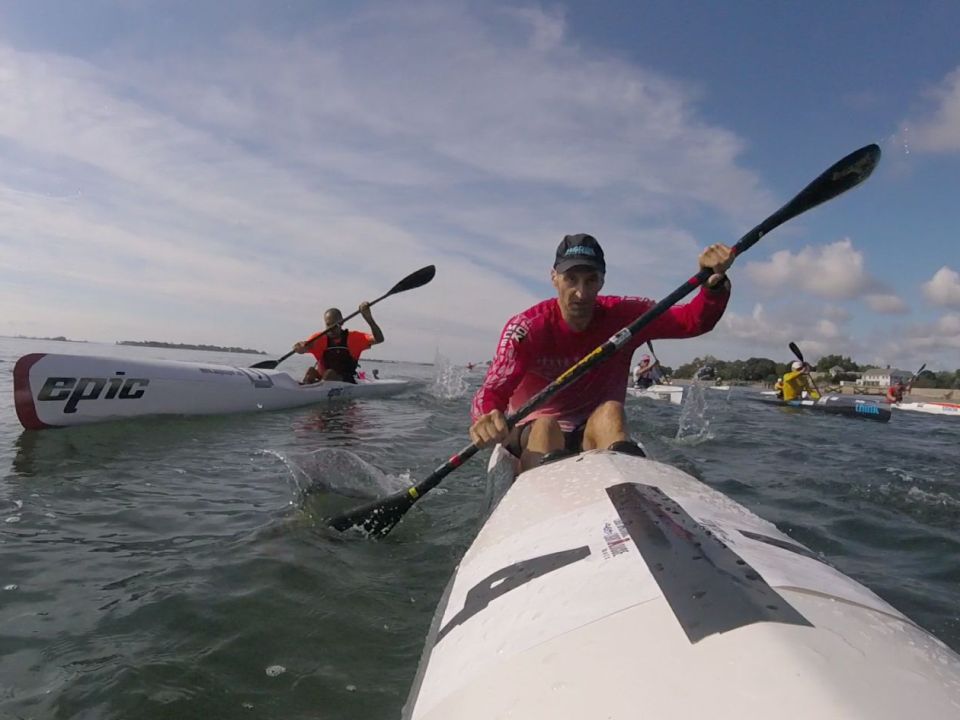
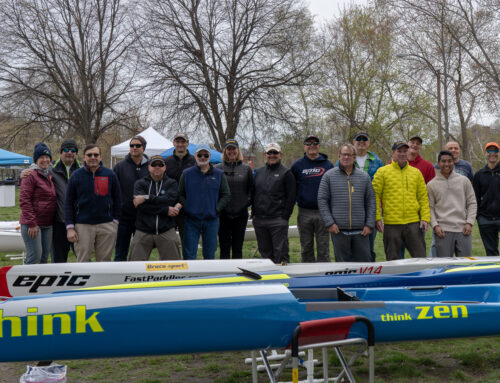
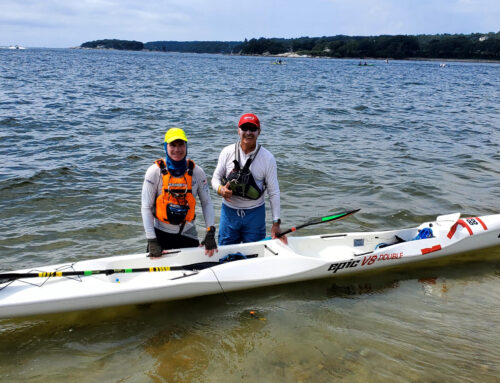
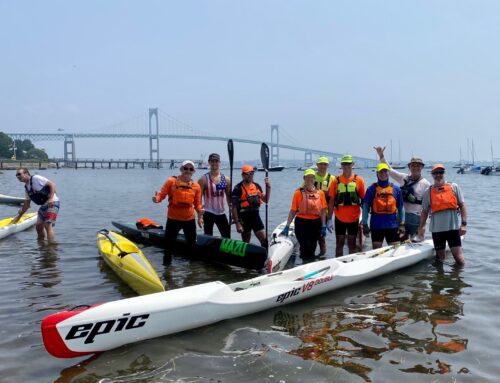
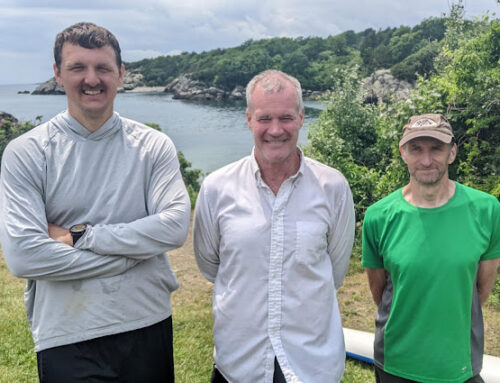
Leave A Comment
You must be logged in to post a comment.